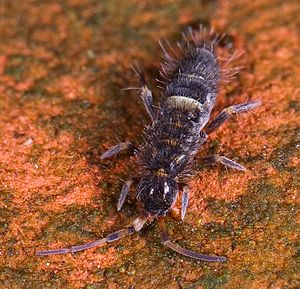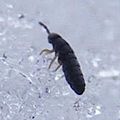Springtail facts for kids
Quick facts for kids SpringtailsTemporal range: early Devonian
to present |
|
|---|---|
 |
|
| Orchesella cincta | |
| Scientific classification | |
| Kingdom: | |
| Phylum: | |
| Subphylum: | |
| Class: | |
| Subclass: |
Collembola
Lubbock, 1870
|
Springtails (Collembola) are tiny, six-legged creatures. They are a type of arthropod, which means they have an outside skeleton and jointed legs. Even though they have six legs, they are not considered true insects. Springtails are found almost everywhere on Earth, from cold polar regions to hot deserts. They are very common in soil and leaf litter.
They live in the soil and eat many tiny things. Their diet includes fungal hyphae (parts of fungi), spores, pollen, and other tiny pieces of dead plants. They need moist soils to survive. Sometimes, they can cause minor damage to young crops or seedlings, but this is not very common.
Contents
What Are Springtails?
Springtails are small, usually less than 6 millimeters long. They get their name from a special organ called a furcula. This is a fork-like tail that is usually tucked under their body. When a springtail needs to escape danger, it quickly releases its furcula. This snaps down and pushes the springtail into the air, making it jump far away. It's like a tiny trampoline!
Unlike insects, springtails do not have wings. They also have a special tube on their belly called a ventral tube or collophore. Scientists believe this tube helps them absorb water and stick to surfaces. Their bodies are often covered in tiny hairs or scales.
Are Springtails Insects?
For a long time, scientists thought springtails were a very old type of insect. However, we now know they are different. They belong to a group called Entognatha. This group is closely related to insects but has some key differences. For example, their mouthparts are hidden inside their head, not visible like most insects. This is why they are in their own special group.
Where Do Springtails Live?
Springtails are found in almost every habitat on Earth. They are especially common in places with lots of moisture and decaying plant material. You can find them in:
- Soil: They live deep in the soil, helping to break down organic matter.
- Leaf litter: They hide and feed among fallen leaves and twigs.
- Under bark: Many species live under the loose bark of trees.
- Compost piles: They thrive in rich, moist compost, helping it break down.
- Snow and ice: Some types, called "snow fleas," can even be seen jumping on snow on warm winter days!
- Water surfaces: A few species live on the surface of ponds or puddles.
They are very important for healthy ecosystems.
What Do Springtails Eat?
Springtails are mostly decomposers. This means they help break down dead plants and other organic material. Their diet includes:
- Fungi: They love to eat fungal threads (hyphae) and spores.
- Pollen: They can feed on pollen grains.
- Algae: Some species graze on tiny algae.
- Bacteria: They also consume bacteria found in the soil.
- Dead plant matter: They help recycle nutrients by eating decaying leaves and wood.
By eating these things, springtails help to create healthy soil. They turn dead material into simpler forms that plants can use to grow. This makes them a vital part of the food web in many environments.
Life Cycle of Springtails
The life cycle of a springtail is quite simple. They go through a process called ametabolous metamorphosis. This means they do not change much in their appearance as they grow.
- Eggs: Female springtails lay tiny eggs, often in moist soil or leaf litter.
- Nymphs: When the eggs hatch, tiny springtails emerge. These young springtails, called nymphs, look like smaller versions of the adults.
- Molting: As they grow, springtails shed their outer skin (exoskeleton) many times. This process is called molting. Unlike insects, springtails continue to molt even after they become adults.
- Adults: After several molts, they reach their full size and can reproduce.
Springtails can live for several months to a year, depending on the species and conditions.
Why Are Springtails Important?
Even though they are tiny, springtails play a huge role in nature.
- Soil health: They help break down dead plants and fungi. This returns important nutrients to the soil, making it fertile for new plants to grow.
- Food source: Many other small creatures, like mites, spiders, and some insects, eat springtails. They are an important part of the food chain.
- Environmental indicators: Because they are sensitive to changes in their environment, scientists can study springtails to learn about the health of the soil.
They are a sign of a healthy, living soil ecosystem.
Images for kids
See also
 In Spanish: Colémbolos para niños
In Spanish: Colémbolos para niños







